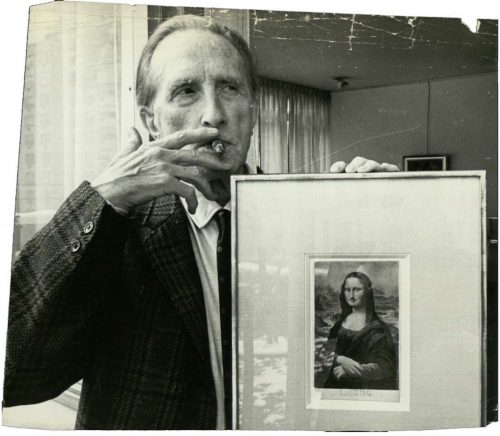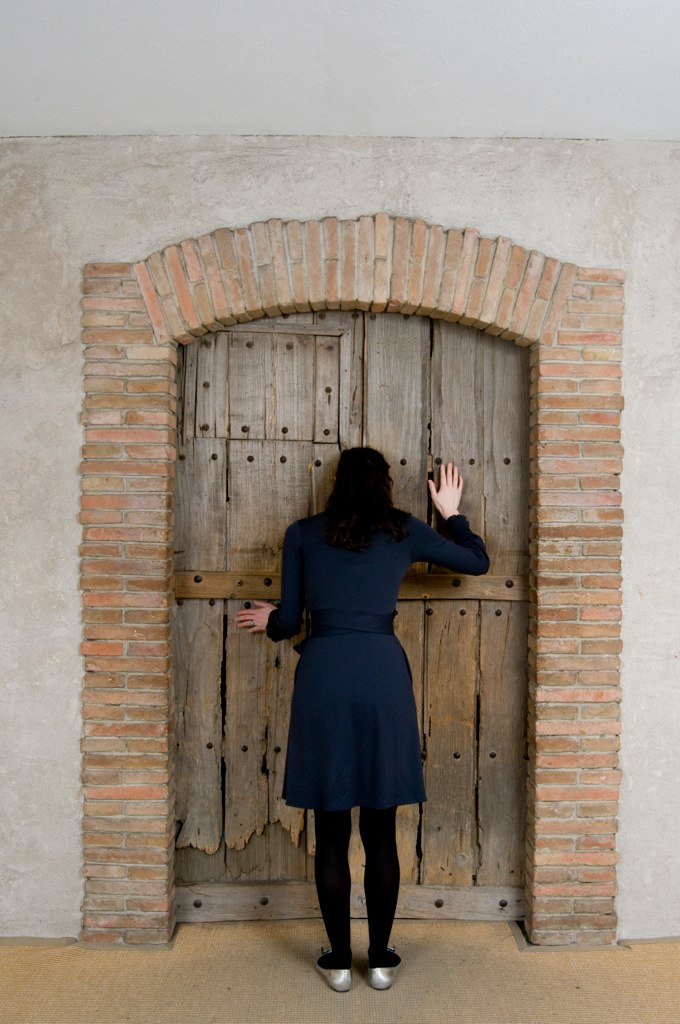
Corona Virus? Does Duchamp Again Make History in Philadelphia?
Years and years ago, Marcel Duchamp created the Large Glass – probably the most forward-looking and influential artwork made in the 20th century. To the good fortune of Philadelphians, this work, along with many other seminal Duchamp creations, now resides in the Philadelphia Museum of Art.
I. Background
One of the ground-breaking features of the Large Glass is that it’s a free-standing panel of GLASS, set in the middle of a room, not a canvas hanging on a wall. Actually, Duchamp called it a ‘Delay In Glass’, this ostensibly to reduce the static ‘picturetude’ and enhance the dynamic ‘imageness’ of the work – generally he thought backgrounds in paintings were “all that garbage”. (From Unpacking Duchamp, Dalia Judovitz, University of California Press, 1995, PP. 59/60) AND because of its transparency, what any given viewer sees depends totally on what is happening on THE OTHER SIDE OF THE GLASS. Is he seeing a radiator? Another Duchamp on the wall? A corridor? A museum security guard? His spouse? What the looker SEES is …
always variable from day to day, depending on the mixture of the people and objects on the other side of the glass, and
totally dependent on where he is standing while he’s doing the LOOKING.
The Large Glass broke new ground with this idea…. (You might even say it broke itself in the process!)
II. Middle Ground
Sometime in 1946, Duchamp began a new project. He worked on its construction in secret for 20 years.
To the outside world, he had ceased painting and now just played chess, smoked his pipe, and generally came and went in the art world. Curious reporters would ask him “What are you working on now?” He would never lie but would spin out a ‘well-crafted-truth’ like: “… I haven’t given up painting; If I get an idea for a painting tomorrow, I’ll do it.” (Hyperallergic, 2014) Then, he’d probably smile, take a little puff on his pipe. Rinse and repeat – for 20 years.
All this came to pass as: “Étant donnés.” The piece was silently installed in its own little room in the Philadelphia Museum a few steps away from the Large Glass. It was opened in 1969 on the anniversary of his passing.
“Étant donnés’” most revolutionary idea – Duchamp’s AHA! Moment. He said to himself something like:
“SELF, for years they’ve been enjoying and deciphering my Glass. It’s the universal un-pin-down-able image, the final destruction of the figure-on-ground idea because the ground won’t hold still! When the viewer moves, the relationship moves, the picture recomposes. Neat eh?! – Now I will really show ‘em something new.”
He thought, I will make an image where every single viewer: tall, short, young, old, summer, fall, winter, spring will see EXACTLY THE SAME THING. I will make it impossible for them to see anything else. Now as a Philadelphian, and reader of this piece, you most likely will have seen the work and know exactly what I am talking about. And this brings us to:
III. Now

If you haven’t seen “Étant donnés,” during this time of Corona – you must now risk your life to see it! You must come within inches of, almost press your nose against, all but kiss, “Étant donnés,” to explore what is behind its ominous doors.
There are menacing works by Damian Hirst, but you don’t need a mask to view them.(Daily Mail, 2011) Here, you must protect yourself from the artwork. When it was first shown, the “porno” content of “Étant donnés” was considered “dangerous”. Now there is real danger, and it’s the work itself; it would only be benign if you owned it and were its sole viewer whose fingers touched it and whose exhalations of droplets dispersed in the air around it.
Will there be a Lysol-Mechanic there to hose it down after every visitor? To spare you this, will they try to create a holographic simulacrum of the contents? The inescapable thought that “I could die from this” will be crossing every viewer’s mind from now till there is (blessedly) a cure.
I doubt this was Duchamp’s intent, but he has created the first work that the viewer must risk his/her life to truly experience. But genuinely great works of art always evoke viewpoints well beyond the time and purpose of their creator’s original intentions. That’s WHAT MAKES GREAT WORKS GREAT! And if you are careful – worth risking your life to see.
Norman Dolph is an Honorable Mention Awardee in the 2018 Artblog Art Writing Challenge. Read his winning essay, “My Coffee with Duchamp.” More about Norman Dolph:
Let’s see… Studied H.o.A & Engineering @ Yale. Long-time art collector, generally black-and-white – Baldessari, Ryman, Artschwager, Marden – that sort of thing. Produced The Velvet Underground & Nico for Warhol (“The Banana Album”). In Philadelphia at the ICA, 1965, did the music for Warhol’s first major show. As a painter, did a Stations of the Cross series – exhibited at the 6th Biennale of Sacred Art at the Museo Stauros d’Arte – Teramo, Italy. As a songwriter, “Life Is A Rock (But the Radio Rolled Me)” and Jane Olivor’s “Stay the Night.” Plus, cuts by Isaac Hayes, Patti LuPone, Eddie Kendricks, Bill Medley, Tracey Ullman. Other stuff too…Long-time friend, patron and collector of the late Paul Laffoley. Happily married! A variegated, enjoyable, optimistic, Vita Brevis.









